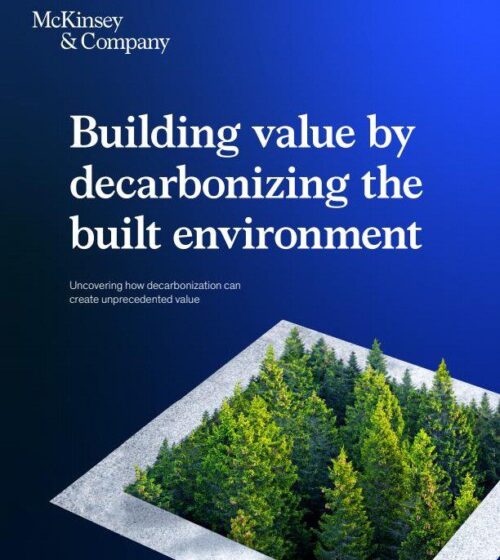McKinsey & Company: New report reveals that more than 50% of built environment emissions can be reduced with existing technology by 2030

In collaboration with the Net Zero Built Environment Council, McKinsey identifies the top levers and business opportunities for decarbonization of the built environment.
13 June 2023: Latest analysis from McKinsey & Company (McKinsey) uncovers that industry players in the built environment have the potential to reduce emissions by more than 50% by 2030 with currently available technologies. It identifies several business opportunities across the value chain that could lead to cost-effective decarbonization for the sector in its latest report: Building value by decarbonizing the built environment.
Looking at over 1,000 potential decarbonization levers for the built environment, McKinsey identifies the top 30 that can be used to decarbonize buildings – many of which are either already cost effective relative to conventional practices or are expected to be at or close to cost parity by 2030 if industrialized.
To capture economic benefits, industry players will likely need to act decisively to increase production of technologies and materials, build service companies, unlock supply chains, and develop the necessary operational skills across the value chain to implement solutions at scale. For example, approximately 60% of built environment operational emissions come from space cooling, space heating, and water heating. Heat pumps could abate up to 60% of heating and cooling emissions for most building types. However, the heat pump supply chain currently is experiencing manufacturing and supply chain bottlenecks that providers would have to solve.
Erik Sjödin, Partner at McKinsey & Company commented: “The report highlights potential pathways to decarbonize the built environment and presents many proven and available technologies and solutions that companies in the ecosystem can implement today, and often cost-effectively. We have aimed to focus on some of the largest opportunities that industry players could realize by scaling production, building future operating models, and developing skills and expertise across the value-chain.”
Brodie Boland, Partner at McKinsey & Company adds: “The built environment is a crucial sector for decarbonization, and companies in this sector have a unique opportunity to capture value and build businesses, while enabling the transition to a low-carbon world.”
To download the report: Building value by decarbonizing the built environment, visit: https://www.mckinsey.com/industries/engineering-construction-and-building-materials/our-insights/building-value-by-decarbonizing-the-built-environment
Notes
McKinsey identifies a number of business opportunities across the value chain that can lead to cost-effective decarbonization for the built environment:
- Industrialize production of green materials – Opportunities in this space include decarbonizing production processes for existing materials and increasing the production of new green material alternatives, such as natural-fiber insulation and engineered wood.
- Industrialize production of energy-efficient building technology – Approximately 60 percent of built environment emissions come from space cooling, space heating, and water heating. Heat pumps can abate up to 60 percent of heating and cooling emissions for most building types, however, the heat pump supply chain currently is experiencing manufacturing and supply chain bottlenecks that providers would have to solve. There is an opportunity to scale the production of heat pumps and related components by industrializing manufacturing, strengthening supply chains, and implementing operational excellence best practices.
- Deliver efficient energy and electrification upgrades – There is opportunity for stakeholders to consolidate services to create integrated packages of key decarbonization solutions to ease the transaction costs of decarbonization upgrades.
- Design and engineer both green and cost-effective structures – D&E firms will likely play an important role in driving decarbonization within the built environment by expanding their service offerings and cultivating their design capabilities to leverage green technologies.
- Electrify onsite construction – Electrification of construction equipment can be cost-effective by 2030 if industrialized, and major construction equipment manufacturers continue to expand their offering of electric construction equipment. OEMs likely have first-mover and scale advantages in developing electric construction equipment and improving existing battery technology.
- Minimize waste and maximize speed offsite build – McKinsey estimates that offsite construction will help reduce construction time by approximately 20 percent and that modular construction in European and US markets can potentially create $22 billion in annual savings. These incentives could create exciting opportunities for companies looking to unlock the barriers to the large-scale deployment of modular construction solutions.
- Validate and certify low carbon actions and solutions – Establishing trustworthy and verifiable green credentials is crucial to scaling green solutions. Verified credentials will likely create a stable demand scenario that could empower investors and entrepreneurs to scale these solutions confidently.
- Finance the green transition – The two primary barriers to financing are high capital expenditures and limited insurance offerings. Financing the transition will require new approaches such as offering energy-as-service financing, scaling offerings of green insurance underwriting and offering investments to transition brown-to-green real estate and infrastructure.
About McKinsey & Company: McKinsey is a global management consulting firm committed to helping organizations accelerate sustainable and inclusive growth. We work with clients across the private, public, and social sectors to solve complex problems and create positive change for all their stakeholders. We combine bold strategies and transformative technologies to help organizations innovate more sustainably, achieve lasting gains in performance, and build workforces that will thrive for this generation and the next.
About the Net Zero Built Environment Council: The Net Zero Built Environment Council aims to accelerate the decarbonization of the built environment by increasing transparency on cost-effective pathways, stimulating green growth opportunities, and fostering collaboration among stakeholders. The council brings together a group of over 40 companies across the built environment ecosystem, including real estate owners and developers, investors, construction players, and manufacturers. As a founding partner to the council, McKinsey Sustainability provides convening, research and analytical support.


